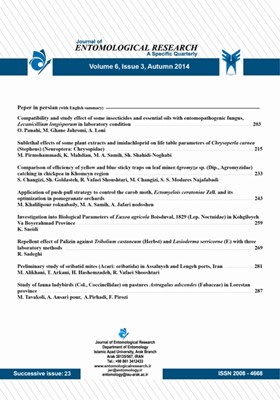Repellent effect of Coconut soap (Palizin) against Tribolium castaneum (Herbst) and Lasioderma serricorne (F.) using three laboratory methods
Subject Areas : entomology and othea arthropods
1 - Department of Entomology and Plant Pathology, Abureihan Campus of Agriculture,
University of Tehran, Tehran, Iran
Keywords:
Abstract :
To alleviate insect pest problems in storage, synthetic pesticides are recommended, but their use may create toxicity to non-target organisms, development of resistance and residues in treated products. Under such circumstances the need for research to find a safe, convenient, durable and economically logical method is necessary. The application of repellents could be considered as a new control method in storage. In this study the repellency effect of Coconut soap (Palizin®) was assayed on Tribolium castaneum (Herbst) and Lasioderma serricorne (F.). Adults and larvae of T. castaneum and L. serricorne exposed to 0, 0.5, 1, 5 and 10% concentration of Coconut soap (Palizin®) (botanical compound) using three techniques such as: filter papers, Y- shape Busvine tube and leaky glass bioassays. In each of three methods, the maximum repellency effect of Coconut soap (Palizin®) was in concentration of 10%, and, the quantities were equal to 78.87, 74.27 and 56.93% for adults of T. castaneum and 72.70%, 85.86% and 45.60% for L. serricorne in Petri-dish, Y- shape Busvine tube and leaky glass techniques respectively.


